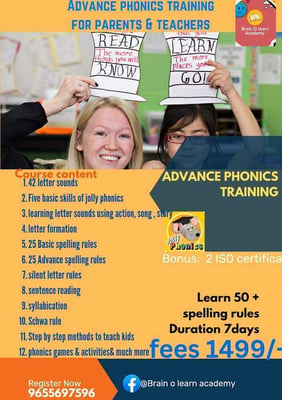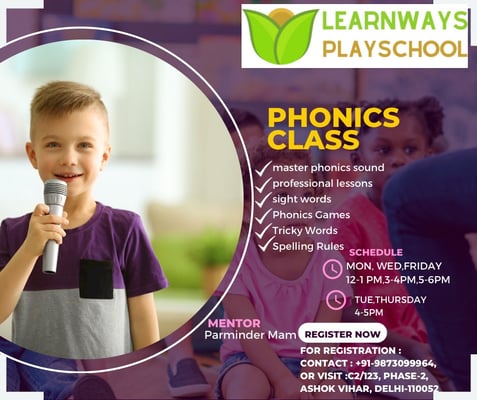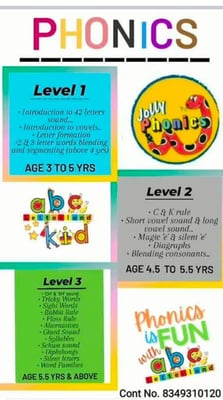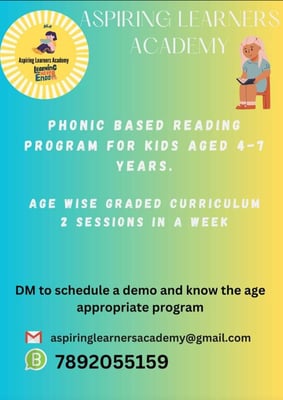Phonics classes for Kids - 90 options found
Phonics classes for children aged 2 to 15 offer numerous ben... Phonics classes for children aged 2 to 15 offer numerous benefits, including promoting literacy development, enhancing language skills, fostering critical thinking, and preparing for academic success. These classes teach children to decode words phonetically, improving reading fluency, comprehension, and writing proficiency. Phonics instruction lays the foundation for strong language and literacy skills, which are essential for academic achievement and career success. By providing systematic and explicit instruction in phonics principles, educators and parents equip children with the skills needed to become proficient readers, effective communicators, and lifelong learners. Phonics classes offer valuable opportunities for children to develop foundational literacy skills that will benefit them throughout their lives. Read more
learnways playschool-phonics class
the learning kids-drawing classes
purple kidz - phonics
the guru academy-admission open
learnways playschool-admissions open
purple kidz - all in one class
jolly phonics- phonics
Advantages of Phonics Classes for Children Ages 2 to 15
Introduction
Phonics classes provide children aged 2 to 15 with foundational skills in reading, writing, and language comprehension through the systematic teaching of phonics principles. These classes offer numerous benefits, including promoting literacy development, enhancing language skills, fostering critical thinking, and preparing children for academic success. In this guide, we will explore the advantages of phonics classes for children in this age range, along with addressing potential limitations and common questions.
Advantages
-
Literacy Development:
- Reading Proficiency: Phonics classes teach children how to decode and pronounce words by understanding the relationship between letters and sounds. This phonetic approach to reading improves reading fluency and comprehension, laying the foundation for literacy development.
- Writing Skills: Phonics instruction also benefits writing skills, as children learn to spell words phonetically and apply phonics rules to their writing. Understanding the sound-symbol correspondence enables children to spell words accurately and independently.
-
Language Skills Enhancement:
- Vocabulary Acquisition: Phonics instruction exposes children to a wide range of vocabulary words as they encounter new words in reading materials. By decoding words phonetically, children develop strategies for identifying and understanding unfamiliar words.
- Comprehension Skills: Phonics classes improve reading comprehension by teaching children to break down words into their constituent sounds and syllables, facilitating comprehension of sentences and passages.
-
Phonemic Awareness:
- Sound Discrimination: Phonics classes develop children's phonemic awareness, or the ability to recognize and manipulate individual sounds in spoken words. Activities such as rhyming, blending, and segmenting help children develop phonemic awareness, which is essential for reading and spelling.
- Syllable Recognition: Children learn to recognize and segment syllables in words, which improves their decoding and spelling skills. Understanding the structure of words helps children break words into manageable chunks for reading and writing.
-
Critical Thinking Skills:
- Analytical Skills: Phonics instruction encourages analytical thinking as children analyze words, identify patterns, and apply phonics rules to decode unfamiliar words. This analytical approach fosters problem-solving skills and logical reasoning.
- Predictive Skills: By understanding phonics principles, children can make predictions about how words are pronounced and spelled based on their knowledge of phonetic patterns. This predictive skill enhances reading fluency and comprehension.
-
Preparation for Academic Success:
- Early Literacy Skills: Phonics instruction provides children with essential early literacy skills that form the basis for academic success in later grades. Strong phonics skills are correlated with improved reading comprehension, writing proficiency, and overall academic achievement.
- Foundational Knowledge: Phonics classes lay the foundation for further language and literacy development, including advanced reading comprehension, writing composition, and language analysis skills.
-
Enhanced Career Opportunities:
- Reading Proficiency: Strong phonics skills are essential for academic success and are correlated with improved career opportunities. Proficient reading skills are necessary for success in various fields, including education, business, healthcare, and technology.
- Communication Skills: Phonics instruction improves communication skills, including reading, writing, and speaking, which are valuable in a wide range of careers and professions. Effective communication is essential for success in leadership, teamwork, and client interactions.
Limitations
-
Individual Differences:
- Learning Styles: Phonics instruction may not be effective for all children, as individual learning styles and preferences vary. Some children may struggle with phonics-based learning and may require alternative approaches to literacy instruction.
- Developmental Variability: Children develop phonics skills at different rates, and some may require additional support or reinforcement to master phonics concepts. Differentiated instruction and targeted interventions may be necessary to meet the diverse needs of learners.
-
Cultural and Linguistic Diversity:
- Language Backgrounds: Phonics instruction may not be suitable for children from diverse language backgrounds or those who speak languages with different phonetic systems. Adaptations and modifications may be necessary to accommodate the linguistic diversity of students.
-
Resource Constraints:
- Access to Materials: Phonics instruction requires access to appropriate reading materials, manipulatives, and instructional resources. Limited access to resources may hinder the effectiveness of phonics instruction and limit opportunities for practice and reinforcement.
Common Questions
-
At What Age Should Children Start Phonics Classes?
- Children can begin phonics instruction as early as preschool or kindergarten, when they are developing pre-reading skills such as letter recognition and phonemic awareness. Early exposure to phonics principles lays the foundation for literacy development and prepares children for reading instruction.
-
How Can Parents Support Their Children's Learning in Phonics?
- Parents can support their children's phonics learning by reading to them regularly, practicing phonemic awareness activities such as rhyming and blending, providing access to age-appropriate phonics materials and resources, and engaging in phonics-based games and activities at home.
-
What Role Do Phonics Play in Learning a Second Language?
- Phonics principles are applicable to learning second languages, as they help learners decode and pronounce words accurately. Phonics instruction can support second language acquisition by providing a systematic approach to learning pronunciation and spelling patterns.
-
Are Phonics Classes Only Beneficial for Children with Reading Difficulties?
- No, phonics instruction benefits all children, regardless of their reading proficiency level. Phonics classes provide essential literacy skills that support reading development, writing proficiency, and language comprehension for all students.
Conclusion
Phonics classes offer numerous advantages for children aged 2 to 15, including promoting literacy development, enhancing language skills, fostering critical thinking, and preparing children for academic success. While there may be limitations related to individual differences, cultural diversity, and resource constraints, the benefits of phonics instruction outweigh the drawbacks. By providing systematic and explicit instruction in phonics principles, educators and parents empower children to become proficient readers, effective communicators, and lifelong learners. Phonics classes lay the foundation for academic success and open doors to enhanced career opportunities in a variety of fields.
























